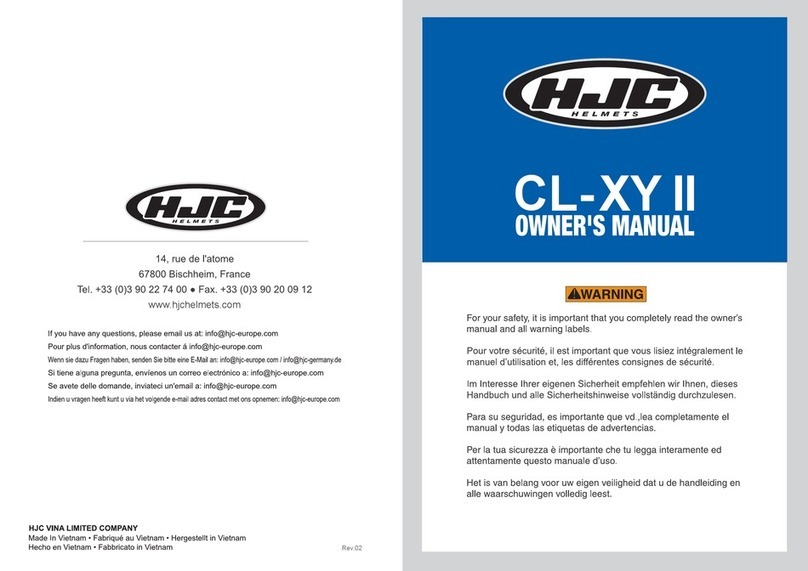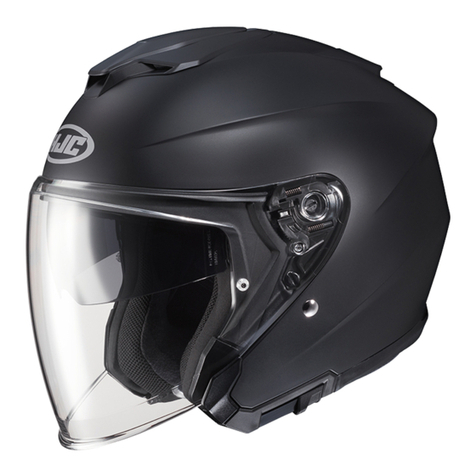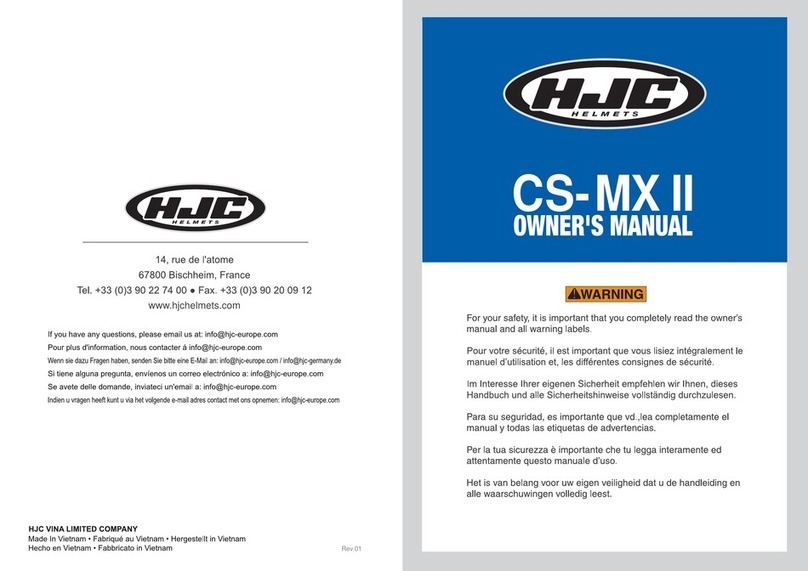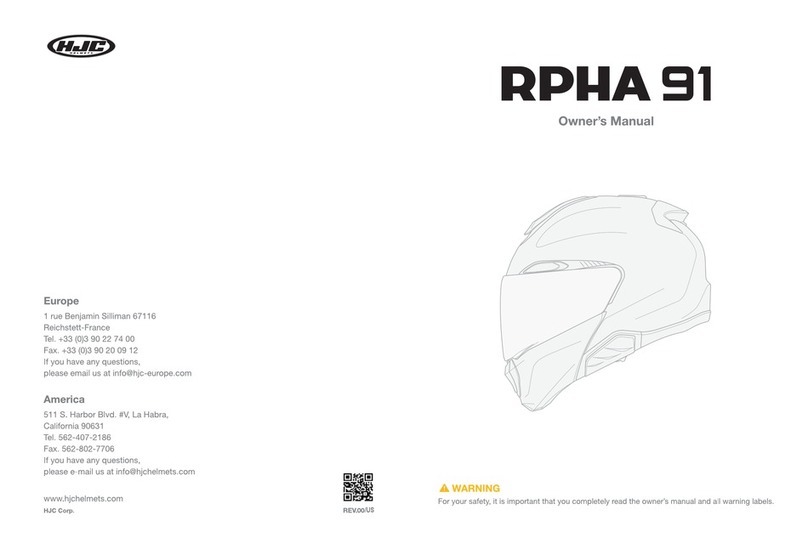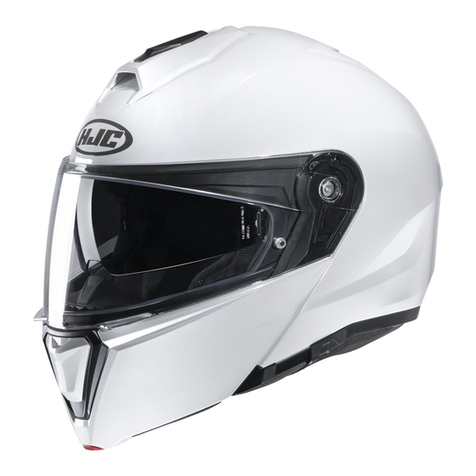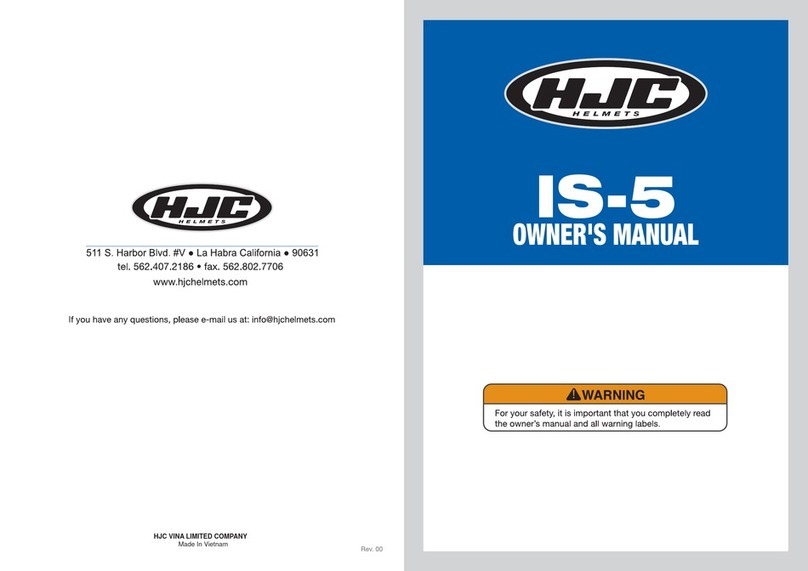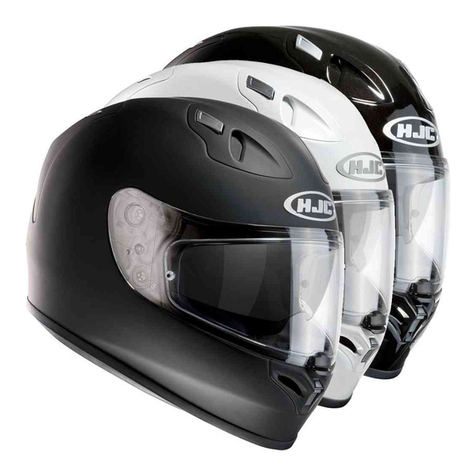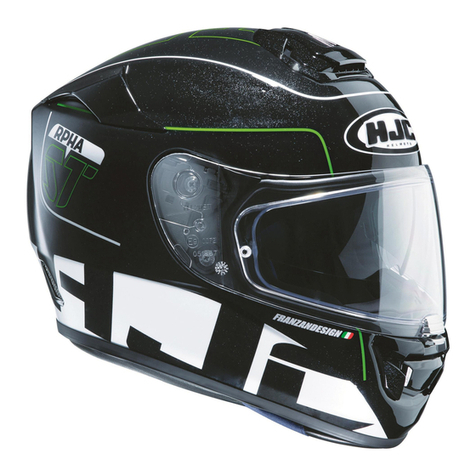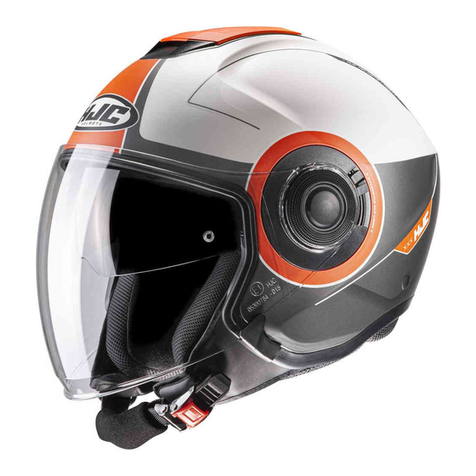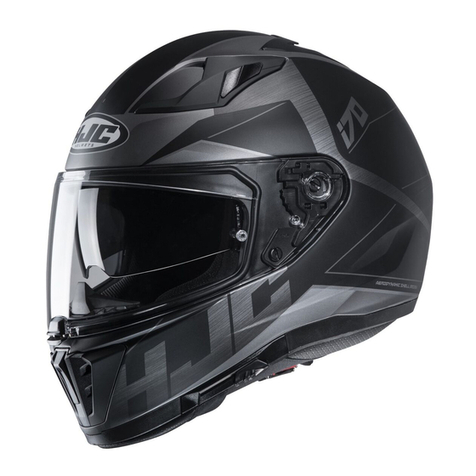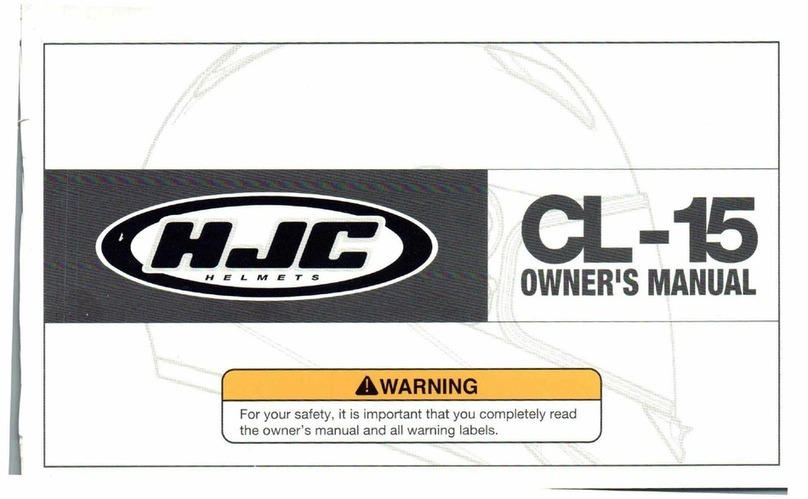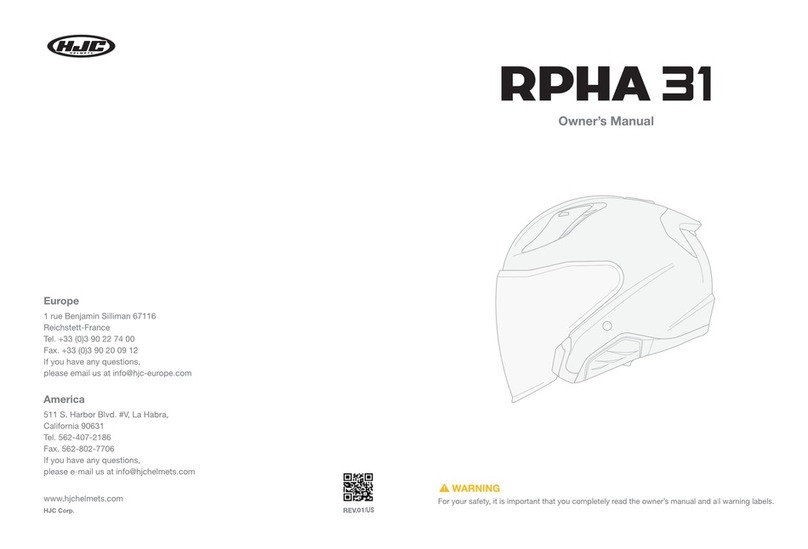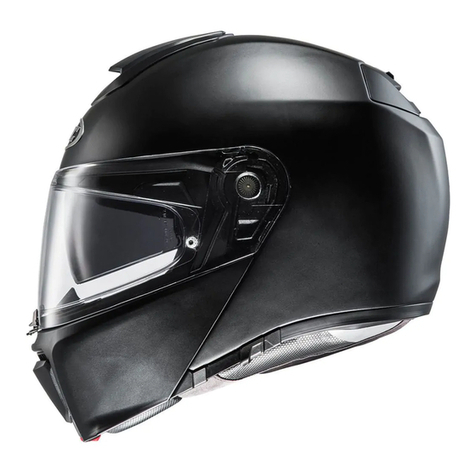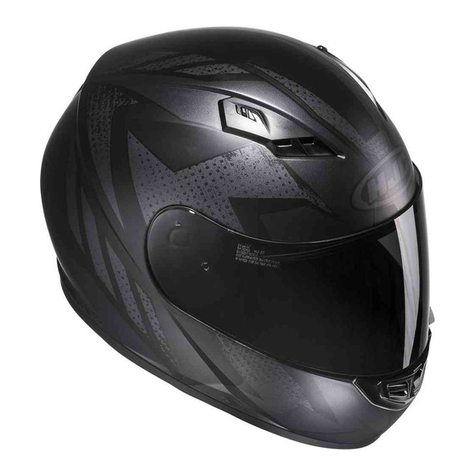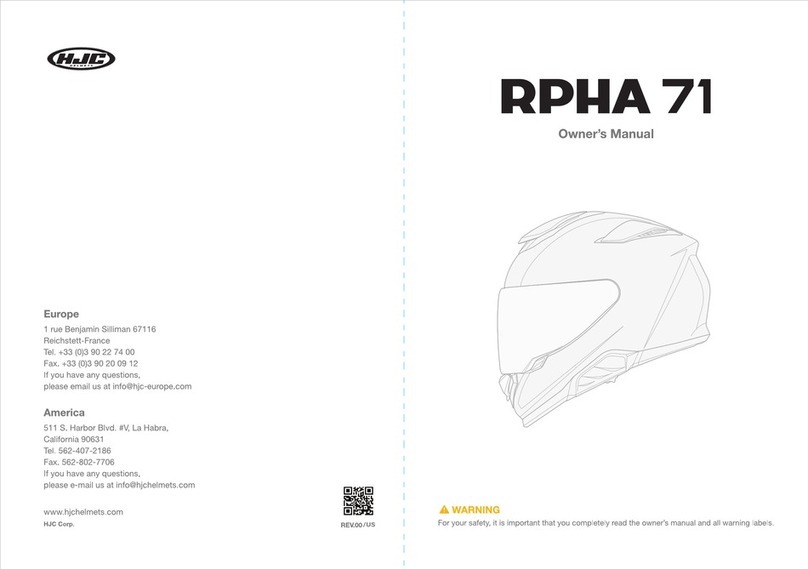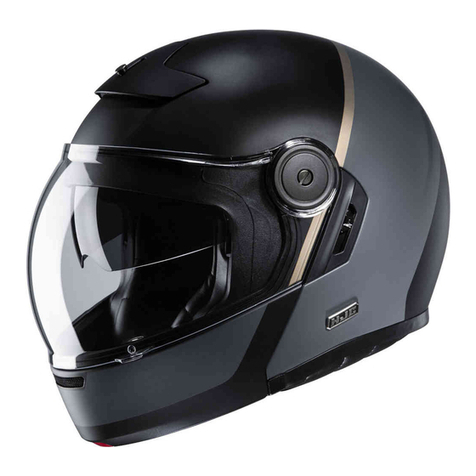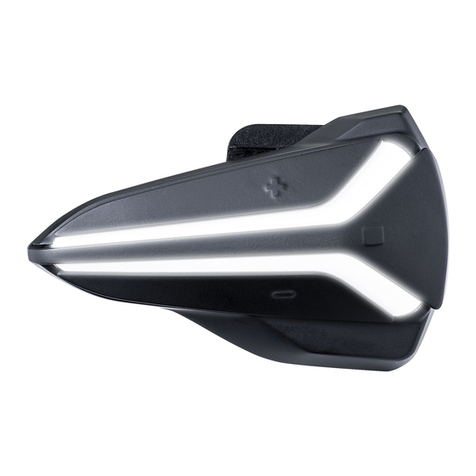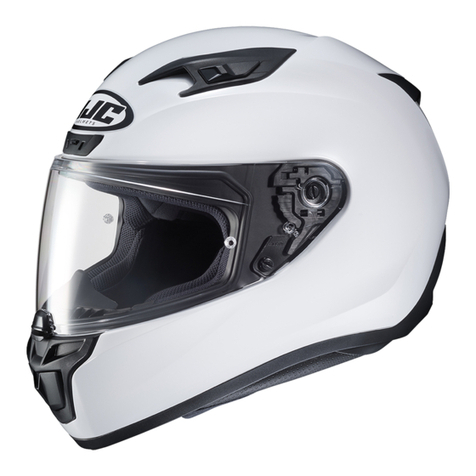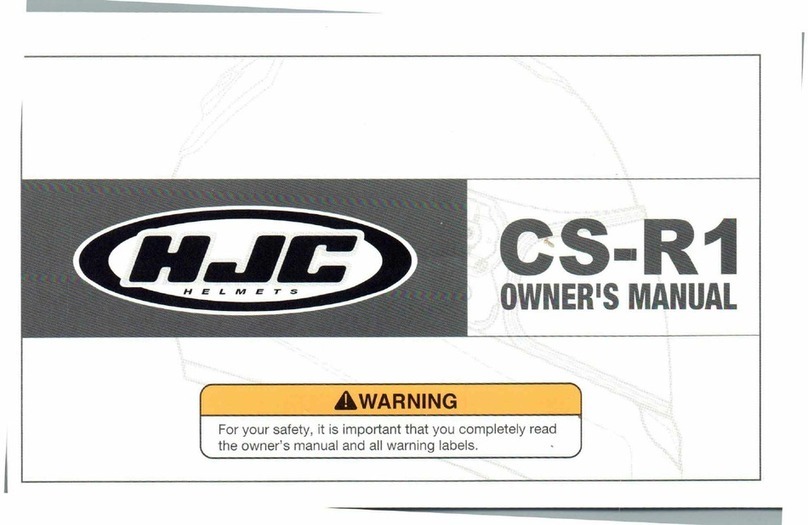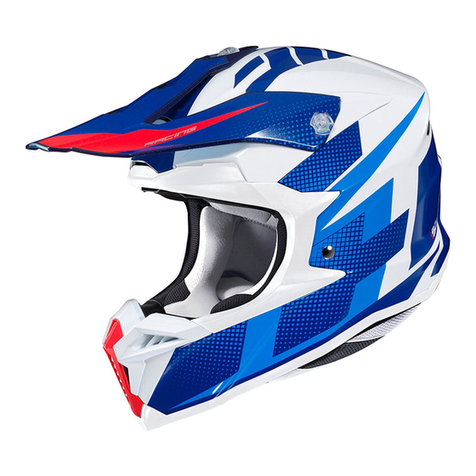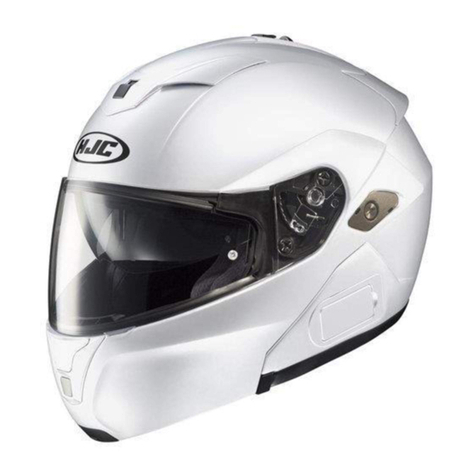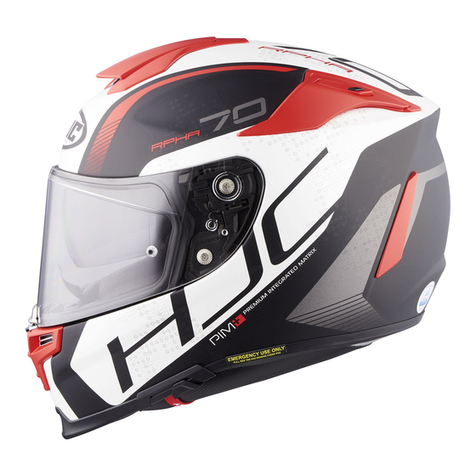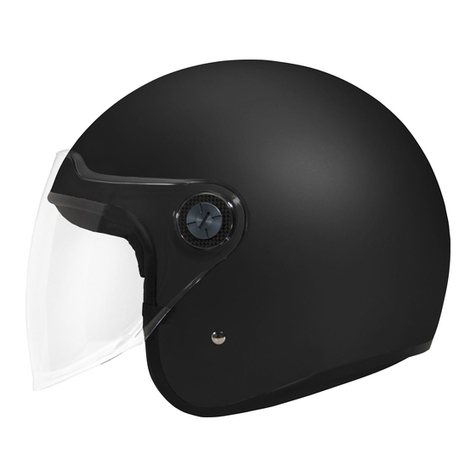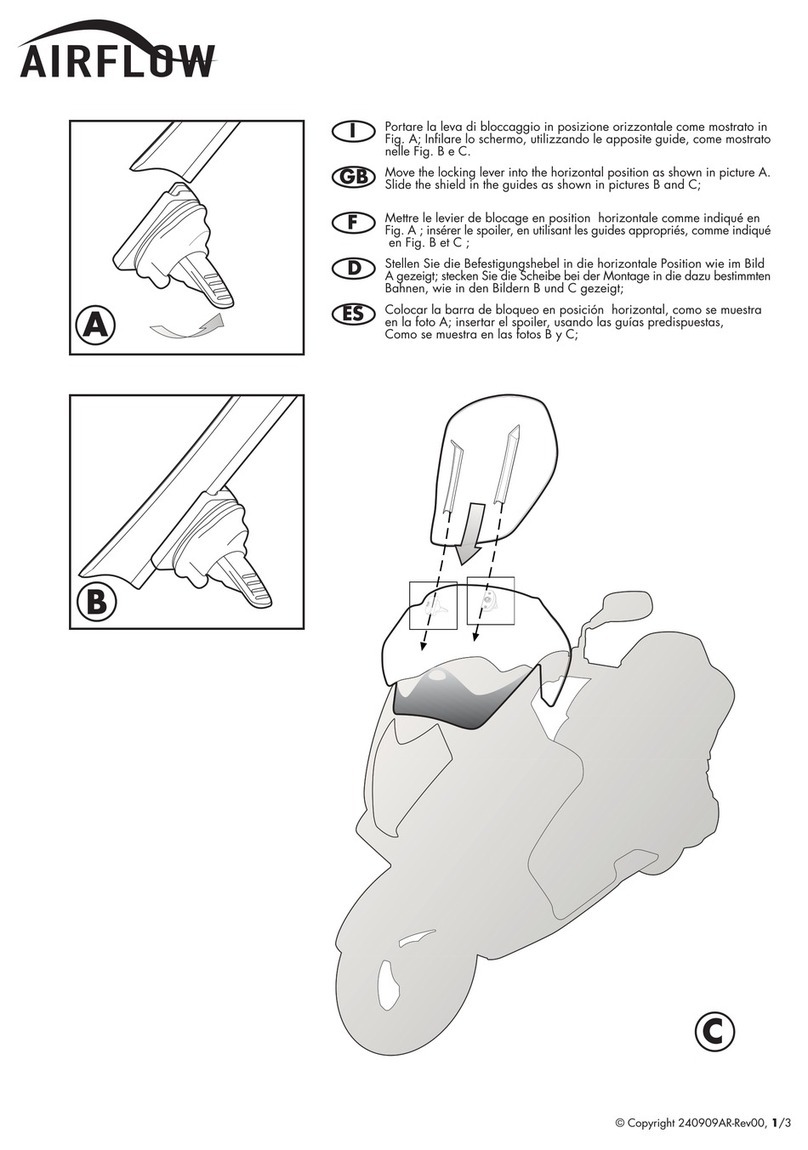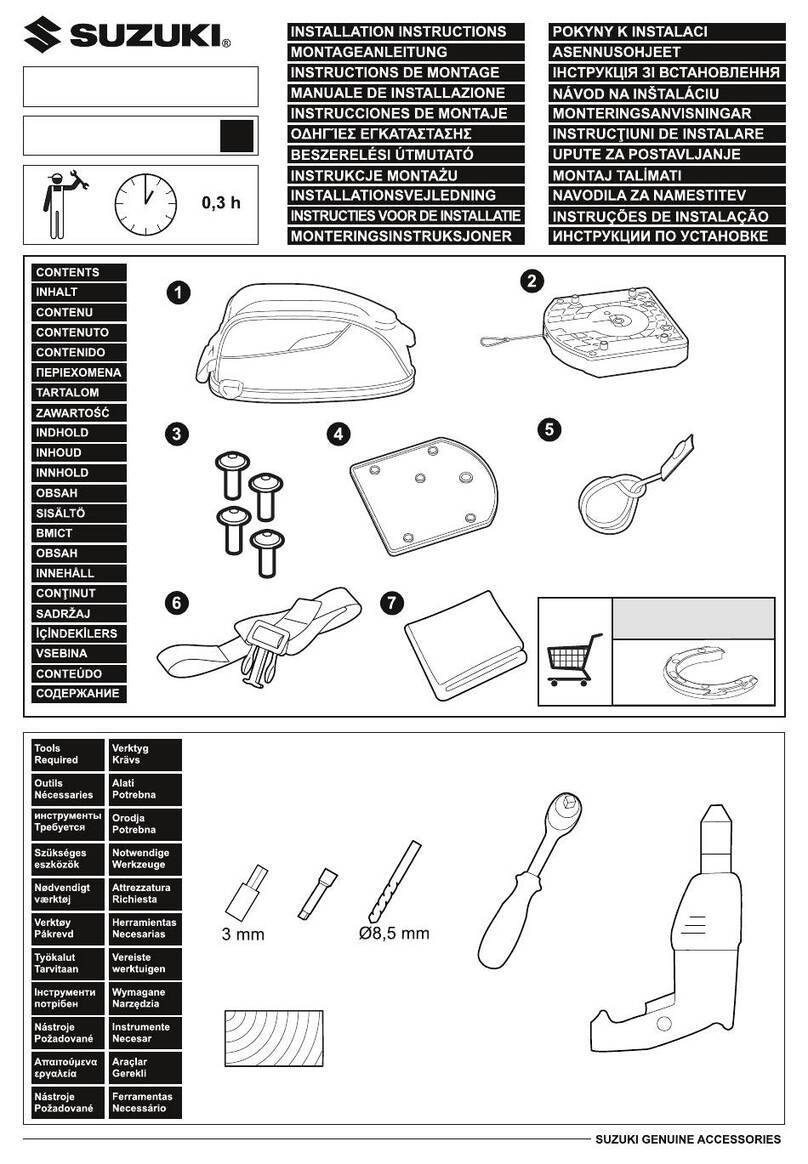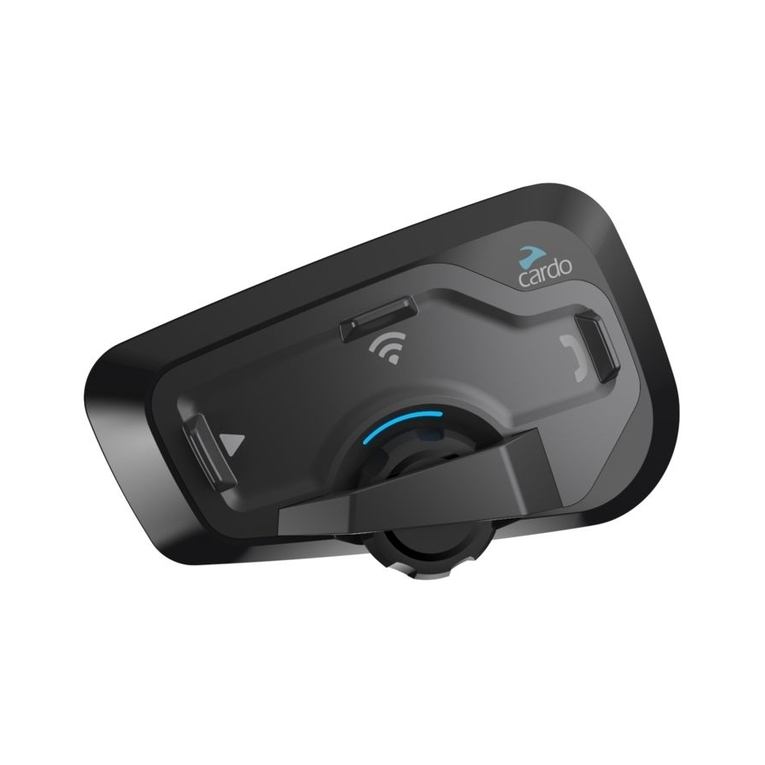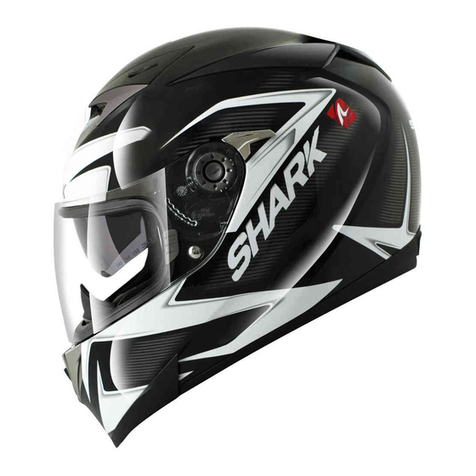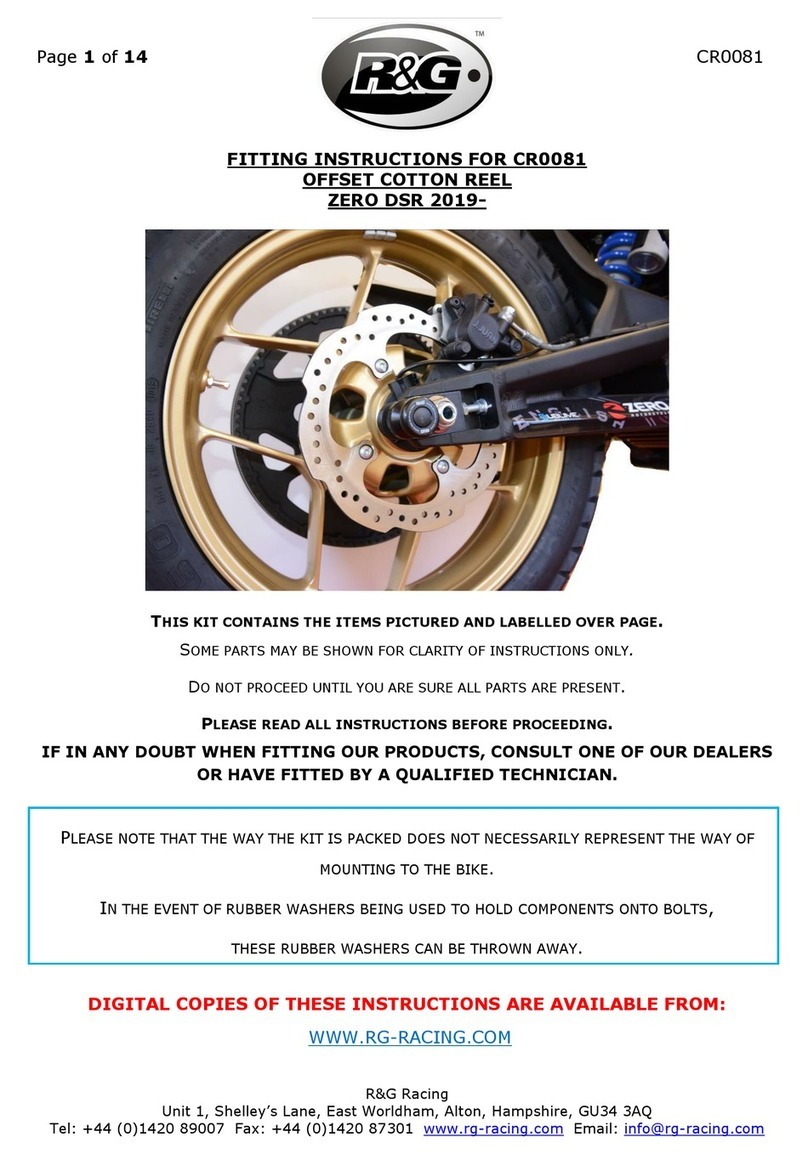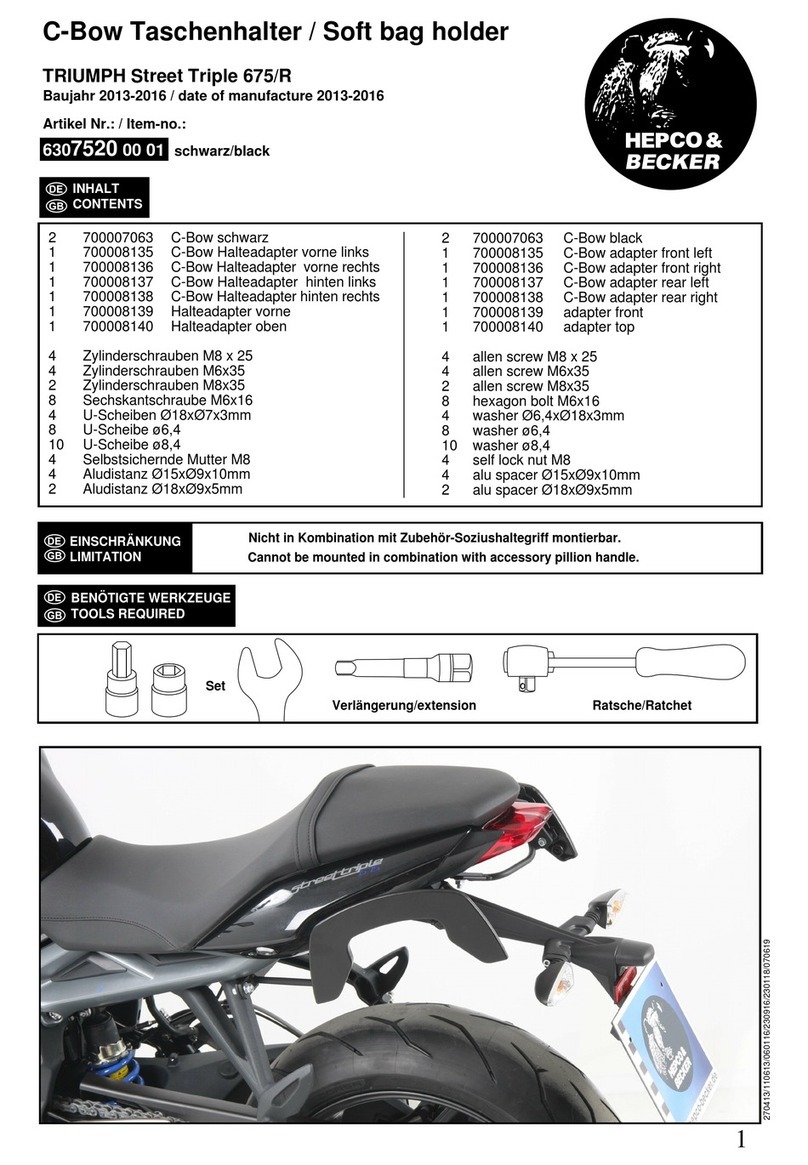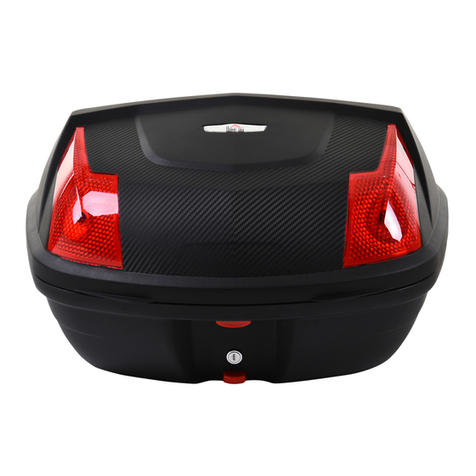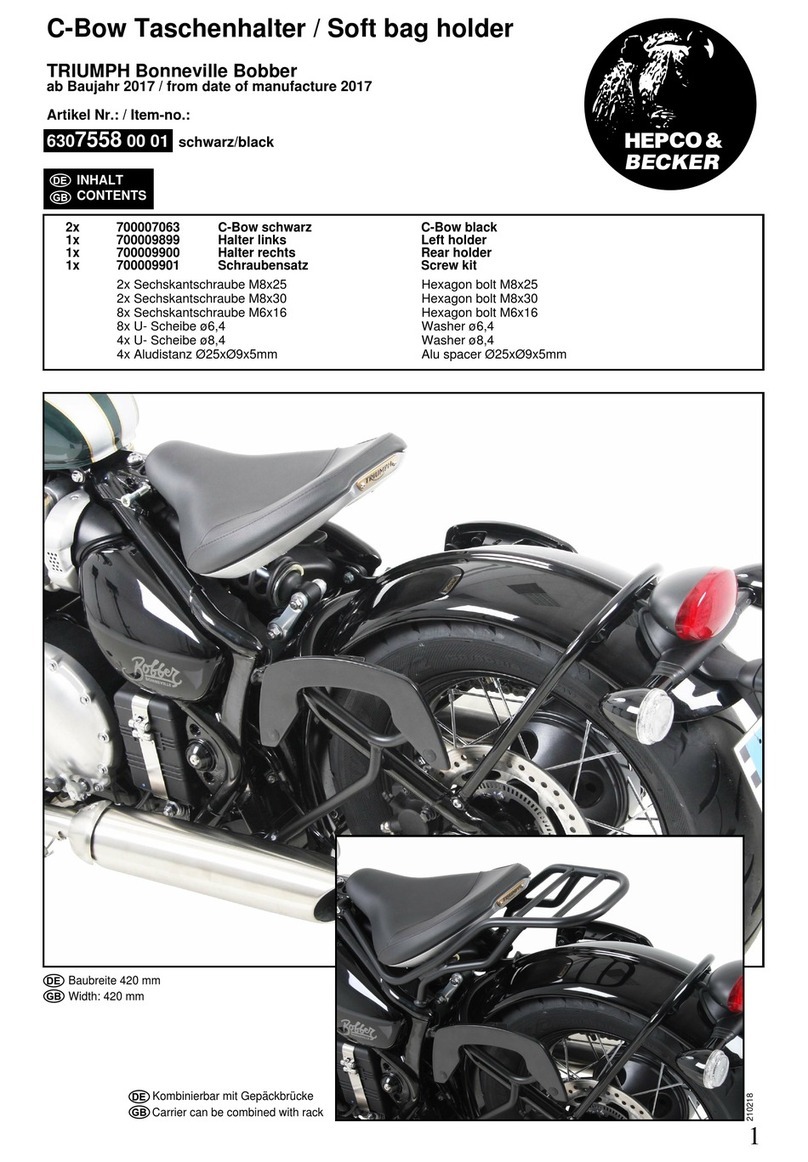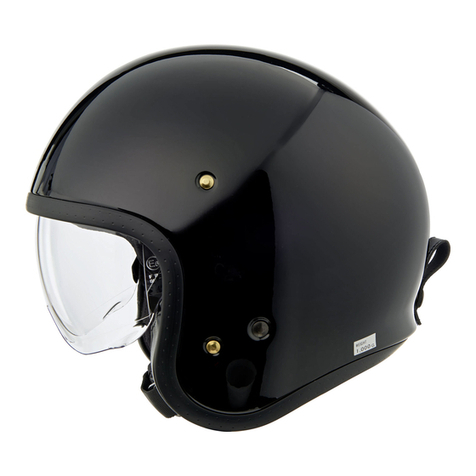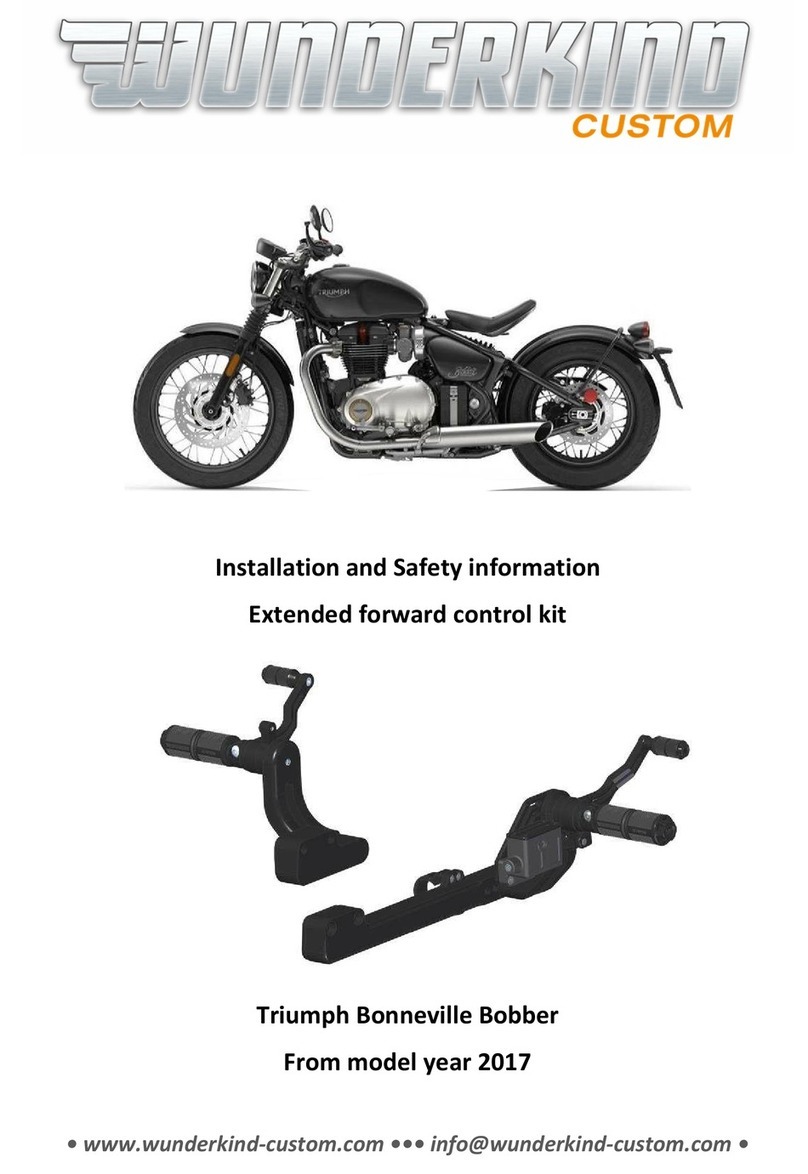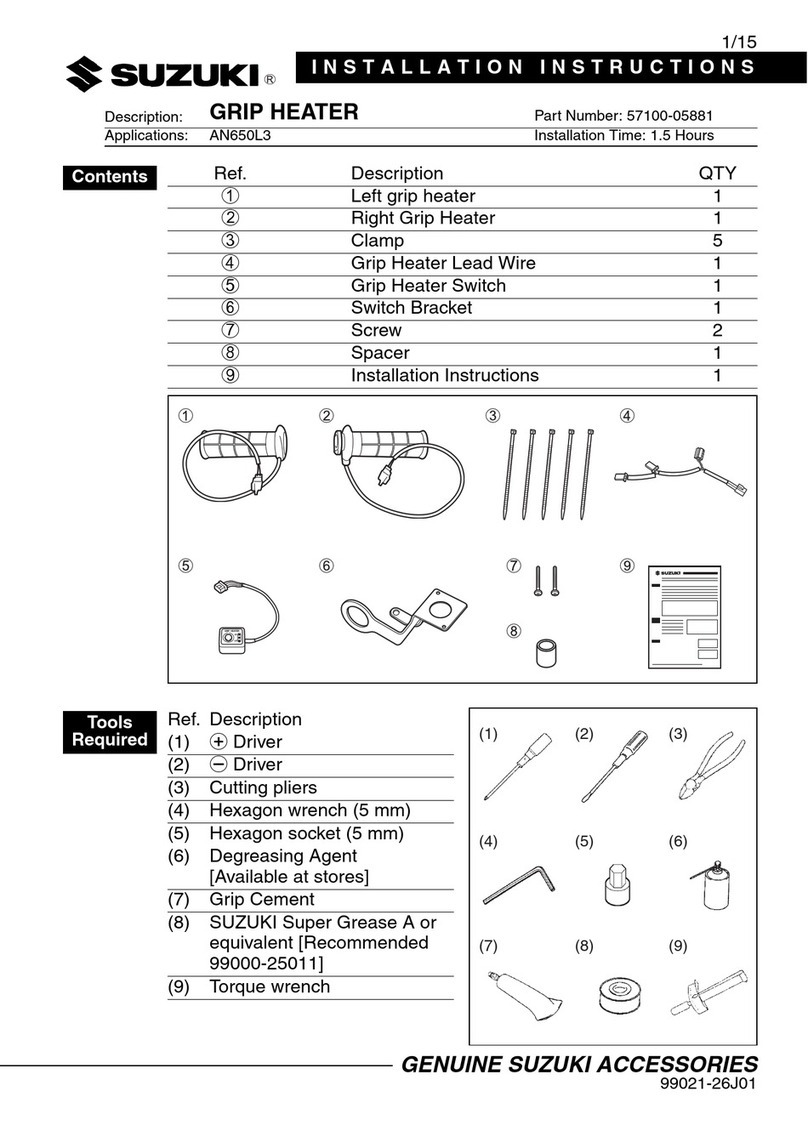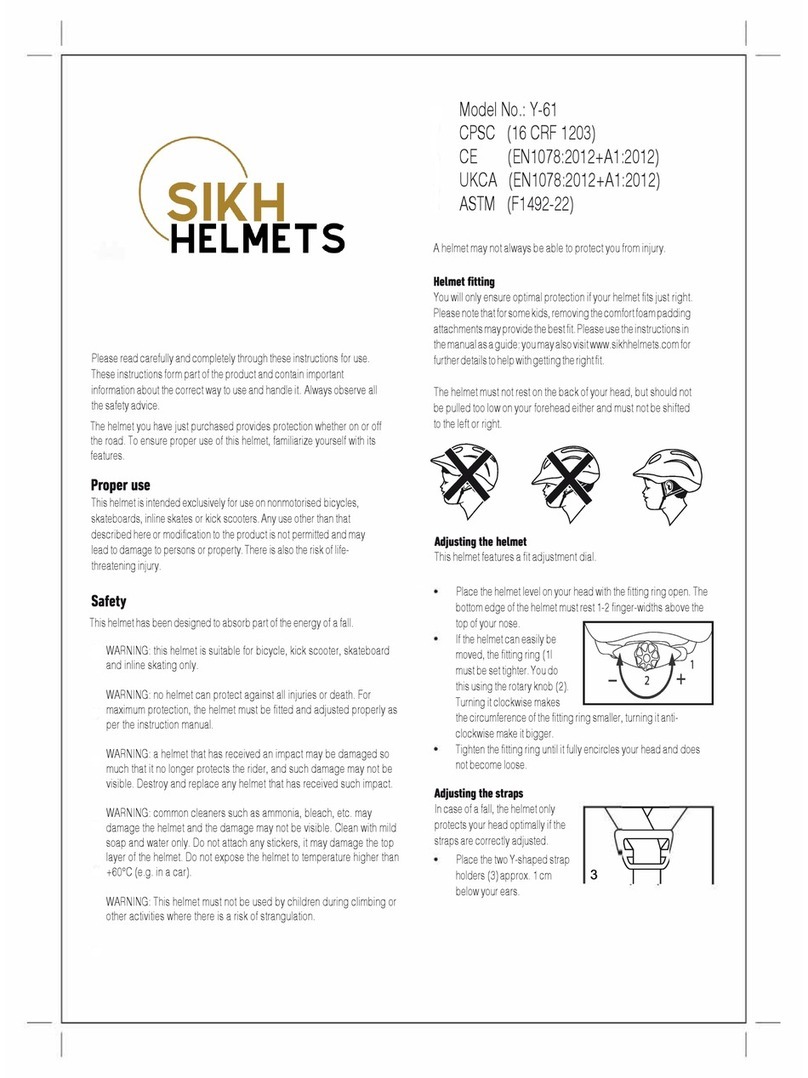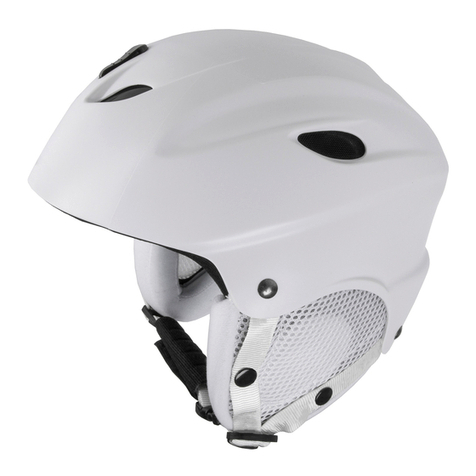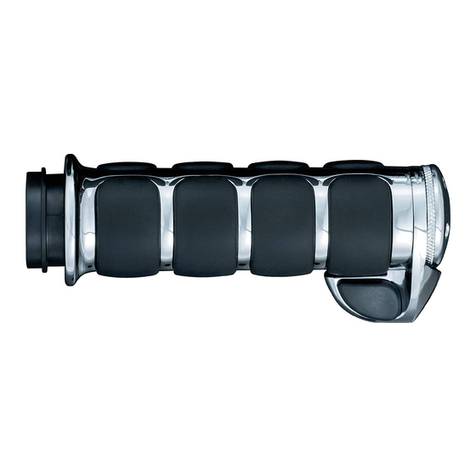HJC CS-15 User manual

CS-15
CS-15
Rev.01
www.hjchelmets.com

English P. 1-6 Français P. 7-12 Deutsch P. 13-18
Español P. 19-24 Italian P. 25-30 Dutch P. 31-36
Contents
Important Safety Information
Specifications
Selecting the Right Helmet
Using Your Helmet Correctly
Inspect your helmet
To ensure that your helmet is in the best condition to maximize your protection, always inspect your helmet for damage
before riding :
• Check
the shield and shield ratchet – re-tighten shield ratchet screws if necessary. Be sure not to over-tighten any
screws. Plastic base plate screws can break and plastic screws can strip the screw sleeves if over-tightened.
• C
heck
for helmet damage. If your helmet is damaged or cracked, stop using it immediately. See “Helmet Replacement” (p. 6)
section for further information. If your helmet has been dropped, you may not be able to see the damage.
• C
heck for worn or damaged parts.
Plastic components may wear out over time. If you find worn or damaged parts, replace them
or purchase a new helmet. See “Replacement Parts” (p. 6) for information on parts replacement.
Check Your Face Shield
If your face shield is scratched or damaged it may reduce the visibility-replace if necessary.
Always make sure you can see well enough to safely operate your motorcycle.
Fasten the Retention System
Fasten the retention system (chin strap) as tight as possible under your jaw without causing pain. There must be no slack in the
strap, and the strap must be snug up against your jaw. If the retention system is not tight, your helmet may become dislodged or
knocked off in an accident.
The instructions in this manual are designed to help you select the right helmet, wear it properly, take care of it, and know when
to replace it. Failure to follow these instruction may increase your risk of serious injury or death in an accident.
In order to get the most protection possible from your helmet, you should always do the following:
• Wear your helmet when you ride;
• Handle your helmet carefully to avoid accidental damage; and
• Ride safely – do not take risks because you are wearing a helmet.
Although your HJC helmet is designed to reduce or prevent some injuries when worn, no helmet can protect you from all possible or
foreseeable impacts. For example, your helmet cannot protect you from spinal or neck injuries. In addition, there is no guarantee that your
helmet will PREVENT injuries to the area of your head that is covered. A low speed accident may even result in serious injury or death.
Never buy a used helmet or borrow someone else’s helmet. Over time the protective foam in helmets will adjust
to the contours of a user’s head. A used or borrowed helmet may not offer as much protection as a new helmet.
Wearing the wrong size helmet can increase your risk of serious injury or death in an accident. A helmet that is
too large for your head may be dislodged or knocked off in an accident. To select the right size helmet for your
head, follow these instruction :
The size chart is only for reference. Always
try the helmet on and follow this manual's
instructions for a proper fit.
Always make sure you can see well enough to safely operate your motorcycle.
To reduce the risk of serious injury or death, always use your helmet correctly.
If parts fall off while riding, your vision may be blocked which could cause an accident.
• Check the retention system (chin strap) for damage. If it is frayed or ripped, replace the helmet.
• Check that all pads are in place. Both of the cheek pads and the crown pads must be in place.
If helmet comes off or shifts over your eyes, try another size or another model or brand. You must be able
to see the edge in your upper field of vision.
Size Chart
1. Measure your head. Wrap a tape measure around your head about one inch (2.5cm) above your eyebrows.
2.
Use the sizing chart to select the helmet size that corresponds most closely to your head measurement. If your head
size falls between two helmet sizes, try on the larger helmet first and then the smaller size.
6.
Test the helmet fit by placing your hands on each side of the helmet. While holding your head as motionless
as possible, try rotating your helmet from left to right then up and down. If you can feel the helmet padding
sliding on your head, it is too big, try a size smaller. You should feel the helmet move the skin on your
head and face as you try to move the helmet.
7. F
asten the retention system (chin strap) as tight as possible under your jaw without causing pain. There must be no slack
in the strap, and the strap must be tight up against your jaw. See page 2-3.
3.
Try on the helmet by grasping both chin straps to pull the helmet completely onto your head, ensuring that the top of your head
is in contact with the top of the helmet interior.
4.
Check for a proper fit. To make sure your helmet is the right size, check that :
• The helmet inner lining fits snugly around your head.
• The top pad presses firmly on your head.
• The cheek pads contact your cheeks.
• There is no space around your brow under the inner lining. Test this by trying to insert your fingers.
If the helmet does not fit snugly, try on a smaller size.
5.
Check your field of vision when trying on a helmet. Some helmets may obstruct or block your vision when looking left, right, up, or down.
8.
Test the retention system (chin strap)
• Put your hands on the back of the helmet and try to push the helmet off by rotating it forward.
• Put your hands on the front of the helmet above your forehead (or on the chin guard) and try to push
the helmet off by rotating backward.
Repeat steps 3 throught 8 until you find a helmet that fits your head snugly and securely.
1. Outer Shell
2. Rear Venturi Exhausts
3. Impact Absorbent Liner
4. Comfort Liner
5. Rubber Edge Trim
6. Chin Strap
7. Micro Buckle
8. Front Chin Vent
9. Eyeport Gasket
10. Breath Deflector
11. Tool-less Shield
12. Shield Retention Button
13. Shield Ratchet
14. Top Front Vent
CLOSE
CLOSE
OPEN
OPEN
CLOSE
CLOSE
OPEN
OPEN
To reduce the risk of serious injury or death and to help prevent damage to your helmet :
• Never adjust your helmet accessories while riding – Only make helmet adjustments when stopped.
• Never
drop your helmet – Dropping your helmet may crack the shell or damage the protective foam. The damage may
not be visible. Your helmet is only designed for ONE impact. Refer to “Helmet Replacement” (p. 6) for more information on
what
to do
after helmet has been dropped.
• Never wear anything between your head and your helmet – this may reduce the effectiveness of your helmet.
• Never
hang or hook your helmet on anything including mirror stalks or sissy bars - Doing so may cause damage
to the helmet protective foam or liner.
• Never use
insect repellent on or around your helmet – insect repellant may damage your helmet’s shield, shell, protective
foam, or other components.
• Never
expose helmet to gasoline or gasoline fumes – Gasoline may damage your helmet’s shield, shell, protective
foam, or other components.
• Never use a dark or tinted face shield at night or in low visibility conditions.
- If you have any questions on what other substances may damage your helmet, please contact us.
• Always
wear eye protection – If you are not using a helmet with a face shield, always wear eye protection when riding.
Always lock your face shield in place when you are riding.
• Always
be alert for sounds – Your helmet may impair your hearing. However, your helmet is not a form of hearing protection.
• Always store your helmet in its helmet bag when not in use to help reduce accidental surface damage.
1 2

Micro Buckle
Shell Cleaning
Shield Installation
Cheek Pad Removal
Cheek Pad Installation
Interior Cleaning
Only use approved methods to clean the helmet. Using other unapproved chemicals or methods may damage the helmet shell
or lining. A damaged helmet may increase your risk of serious injury or death in an accident.
Glossy Finish. HJC recommends cleaning your helmet with products designed for automotive cleaning and polishing. All HJC
helmets are finished with an automotive type base coat/clear coat finish. Rubbing compounds can be used for deep cleaning to
remove many scratches and scuffs. Follow the product’s instructions diligently. Over polishing with rubbing compounds can cause
light abrasions which may dull the finish of your helmet. Stickers and decals will leave adhesive residue when removed. To remove
the adhesive residue, use alcohol swabs. Be certain to immediately wipe away the excess liquid and clean the area with soap and
water once the adhesive residue is removed. Do not use excessive pressure while rubbing when attempting to remove the adhesive
residue, instead use multiple light treatments.
Non-Glossy Finish. For our flat finish (non-glossy) helmets, we recommend using warm water and mild soap. Use multiple
treatments for heavier dirt. Do not use excessive pressure or rubbing compounds while cleaning the surface as a “glossy” effect
could be created, running the flat finish appearance.
Although we recommend changing a helmet every 3 to 5 years, the accumulation of sweat, humidity and dirt can deteriorate the
fabric and stitching and this may cause odor. To wash HJC removable pads, HJC recommends regular machine washing and air
drying. For non-removable interiors, HJC recommends using bacteria and mildew eliminating products such as “Helmet Fresh.”
1. Move the shield retention button to the open position.
2. Open shield to the maximum open position.
3. Move the handle-locker to the open position.
4. Shield will be automatically released out of base ratchet mechanism.
When the shield is opened
to its maximum open
position, the arrow on the
shield should line up with
the arrow on the
handle-locker.
Vent Cleaning
Shield Removal
Dirt and debris can find its way into venting of your HJC helmet. Compressed air cans used for cleaning computer keyboards may
be used to blow the debris from the ventilation system. It is recommended that you remove any removable pads before doing this
process.
Maintaining Your Helmet Correctly
2. Align and insert the top of the shield guide into
the plate-gear guide.
3.
With the guides properly aligned, press the lower section
of the shield into the plate-gear mechanism. The locking
tab should pop into position, locking the shield into place.
1. Ensure that the handle-locker
is in the open position.
Always check to make sure helmet pads are installed before using the helmet. A helmet with missing or improperly installed
pads may increase your risk of serious injury or death in an accident.
There are 3 snaps holding the cheek pad in place.
1. Gently pry the check pad away from the interior, releasing
the snaps.
2. Grasp the cheek pad near its center and gently pull it free
from the chin strap.
1. Feed the chin strap through the opening in the cheek pad.
2. Align and fully slide the cheek pad plastic plate between shell and EPS.
3. Clip the cheek pad’s 3 small male snaps to the 3 female snaps fixed on the shell interior.
Crown Pad Removal
1. Grasp the crown pad fabric as close as possible and pull/pry away from the helmet.
2. Repeat same at rear.
3 4
Clip
Chin strap
Chin strap
Micro buckle Hold the Clip and pull
the Chin strap as directed
above to adjust the fit.

1.
Align the center of the crown pad’s plastic sleeve with the shell. Force the crown pad’s plastic sleeve in between the shell
and EPS.
2.
Align the left or right end of the crown pad’s plastic sleeve with the shell. Force the crown pad’s plastic sleeve in between
the shell and EPS (one side at a time).
3. Align and snap the two rear snaps into place.
Crown Pad Installation
Breath Deflector Removal
1. Push breath deflector flat and pull away from the helmet as arrows indicate.
Breath Deflector Installation
1. Push breath deflector into specified slot as arrows indicate.
Chin Curtain Removal
1. Grasp the chin curtain fabric (one side at a time) at the bottom corners and
gently pull the sleeve down and away from the shell.
Chin Curtain Installation
1. Center the front plastic sleeve of the chin curtain with the shell.
Force the chin curtain’s plastic sleeve in between the shell and EPS.
Replacement Parts
Do Not Modify Your Helmet
Your HJC helmet is designed to meet ECE R 22-05 standard. Contact HJC Europe for more information about the ECE R 22-05
standard. Modifying your helmet may increase your risk of serious injury or death in an accident. Do not modify your HJC
helmet. Modifications include the following :
• drilling holes;
• cutting shell, liner, or strap;
• modifying the retention system, including adding a chin cup;
• removing parts;
• painting; and
• attaching accessories that are not manufactured by HJC for this helmet.
If you have questions about modifications, please contact HJC, See back cover for contact information.
Always check to make sure helmet pads are installed before using the helmet. A helmet with missing or improperly installed
pads may increase your risk of serious injury or death in an accident.
Even if your helmet has not been damaged, it needs to be replaced every 3 to 5 years depending on how much you use it.
Over time, UV rays and adhesive and component aging will damage your helmet. Wearing a damaged helmet may increase
your risk of serious injury or death in an accident. If you are unsure if you need to replace your helmet, contact HJC Europe
before using your helmet again.
HJC hereby extends a limited warranty to the purchaser of a HJC helmet that the helmet is free of defects in materials and
workmanship.
This warranty is applicable to manufacturer’s defects only and is good up to one year from the date of purchase, It does not
apply to any problems arising out of wearer’s misuse, negligence, modifications, accidents, etc.
Helmet Disposal
Coverage
Any warranty of merchantability and any implied warranty are hereby expressly disclaimed. In addition HJC shall not be liable
for any consequential damages.
Disclaimer
In order to receive warranty, please take your helmet, your receipt showing the date of purchase, and a brief memo that
includes a description of the problem, your name, and phone number tothe authorized HJC dealer from which you purchased
your helmet.
Procedure
An improperly stored helmet san become damaged and may increase your risk of serious injury or death in
an accident. You should:
•
Store helmet in a cool and dry place,
•
Keep helmet away from pets and other animals,
•
Keep helmet away from heat in excess of 50°C and do not set on or near hot surfaces.
•
When helmets left out in the sun for extended periods of time, it may fade overtime.
Although your HJC helmet is constructed with the best materials available to offer a long-lasting product, it
will eventually need to be replaced. Immediately replace your helmet if:
• It has suffered an impact. Your helmet is only designed for ONE impact. An impact may fracture the outer
s
hell or compress the impact absorbing liner. You may not be able to detect this damage.Any impact in
a crash or a drop from as low as 4 feet is enough to damage your helmet.
•
T
he shell, lining, or retention system is damaged. The helmet shell, the impact absorbing lining, and
the
retention system must be in good condition to provide you with the most protection.
If you buy a new helmet, destroy the old one to ensure it cannot be reused. Do not sell or give away your
old helmet, even if it has not been damaged. Over time the protective foam in the helmet will adjust to the
contours of your head. If someone else uses this helmet it will not provide them with as much protection.
Helmet Replacement
Storing Your Helmet Correctly
Warranty
5 6

Informations importantes relatives à la sécurité Spécifications
Choisir le bon casque
Utillisation correcte du casque
Vérifiez votre casque
Afin d'être sûr que votre casque est en bon état pour optimiser votre protection, vérifiez votre casque avant de l'utiliser.
• Vérifiez l'écran et le système de fixation - resserrer le système de fixation de l'écran si nécessaire. Ne pas serrer trop fort
les vis en plastique du système de fixation. Les vis en plastique peuvent casser au niveau de la tige filetée et les vis
plastiques peuvent endommager la douille.
• Inspectez le casque : si votre casque est endommagé ou fissuré, ne l'utilisez plus. Veuillez vous reporter au chapitre
"Remplacement du casque" (p.12) pour plus d'information. Si votre casque est tombé, le dégât peut ne pas être visible à
l'œil nu.
• V
érifiez les pièces d'usure ou endommagées. Les composants plastiques s'usent au fil du temps. Si des pièces sont usées
o
u endommagées, veuillez les remplacer ou acheter un nouveau casque. Cf "Remplacement des pièces" (p. 12) pour plus
d'information sur le remplacement des pièces.
Contrôler votre écran
Si votre écran est rayé ou endommagé cela risque de réduire la visibilité - Remplacez-le si nécessaire. Toujours s'assurer
d'une bonne visibilité pour conduire en pleine sécurité.
Boucler le système de fermeture
Le système de fermeture (boucle jugulaire) doit être bien resserré sous le menton, sans gêner. La boucle jugulaire ne doit
pas être lâche et, doit être bien ajustée au niveau du menton. Si le système de fermeture n'est pas bien resserré, le casque
pourrait bouger et se détacher en cas d'accident.
N'achetez jamais un casque d'occasion et n'empruntez pas le casque à quelqu'un. A force de le porter, l'intérieur
(en mousse) prend la forme de la tête de l'utilisateur. Un casque d'occasion ou emprunté risque de ne pas protéger
autant qu'un casque neuf.
Porter un casque de taille inadaptée peut accroître le risque de blessure ou de décès en cas d'accident. Un casque
trop grand peut bouger ou casser en cas de choc. Afin de choisir la taille la mieux adaptée, veuillez suivre les
instructions ci-après.
Assurez-vous toujours d’avoir une bonne visibilité pour piloter votre moto en toute sécurité.
Afin d’éviter tout risque de blessures graves ou de décès, utilisez correctement votre casque.
Afin d'éviter le risque de blessure grave ou de décès et, d'éviter d'endommager votre casque:
Si des pièces tombent lors de la conduite, votre visibilité peut être réduite, ce qui peut provoquer un accident.
• Contrôler le système de fermeture (boucle jugulaire). S'il est usé ou détérioré, remplacez le casque.
• Vérifiez que la garniture intérieure est en place. Les mousses joues et la garniture intérieure doivent être en place.
Si le casque tombe ou arrive au niveau de vos yeux essayez une autre taille, un autre modèle ou marque.
Vous devez être en mesure de voir le bord dans votre champ de vision supérieur.
GRILLE DE TAILLES POUR LES CASQUES
1. Mesurez votre tête : utilisez un mètre à couturière pour mesurer le tour de tête. Placez celui-ci à environ 2,5 cm au-dessus des
sourcils.
2. Utilisez la grille de tailles pour trouver la taille de casque qui correspond le mieux à votre tour de tête. Si votre tour de taille est
entre deux tailles, essayez d'abord la taille au-dessus puis, la taille en-dessous de celle mesurée.
6. Vérifiez le bon maintien de votre casque en posant les mains de chaque côté. Maintenez votre tête
le plus immobile possible et essayez de tourner le casque de gauche à droite puis, de bas en haut.
Si vous sentez que la garniture intérieure de votre casque glisse sur votre tête, c’est que le casque
est trop grand. Essayez une taille inférieure. Lorsque vous bougez le casque, vous devez sentir le
dessus de votre tête et la peau du visage bouger.
7. Attachez la jugulaire, le plus serré possible sous votre menton sans que cela ne vous fasse mal. Il ne
doit pas y avoir de jeu au niveau de la jugulaire et, celle-ci doit être bien resserrée sous votre menton.
3. Essayez votre casque en saisissant les deux parties de la jugulaire et, enfoncez complètement le casque sur votre tête,
tout en vous assurant que le haut de votre tête touche l'intérieur du casque.
4. Vérifiez le maintien du casque. Assurez-vous de la bonne taille de votre casque, en vérifiant que :
• La garniture intérieure du casque épouse votre tête,
• La garniture tête appuie fermement sur votre tête,
• Les mousses joues soient en contact avec votre joue,
• Aucun espace n'existe entre votre front et la garniture.
Vérifiez ceci en essayant de passer vos doigts.
Si le casque ne vous va pas parfaitement, essayez une autre taille.
5. Vérifiez votre champ de vision lorsque vous essayez un casque. Certains casques peuvent gêner ou réduire votre
champ de vision, lorsque vous regardez vers la droite, vers la gauche, vers le haut ou vers le bas.
8. Vérifiez la jugulaire
• Posez les mains à l’arrière du casque puis essayez de le retirer en le faisant pivoter vers l’avant.
• Posez les mains sur le devant du casque au niveau du front (ou au niveau du cache menton)
puis essayez de le retirer en poussant vers l’arrière.
Répétez les étapes 3 à 8 jusqu’à ce que vous trouviez le casque qui vous convienne parfaitement.
1. Coque extérieure
2. Spoiler arrière avec ouvertures
pour extraction de l'air
3. Calotin intérieur absorbant les chocs
4. Garniture intérieure
5. Joint
6. Jugulaire
7. Boucle micrométrique
8. Aération mentonnière
9. Joint de l’écran
10. Cache nez
11. Ecran
12. Bouton de blocage de la visiére
13. Mécanisme de l’écran
14. Ventilation supérieure
• Ne pas régler votre casque pendant la conduite, Régler le casque une fois à l'arrêt.
• N
e pas faire tomber votre casque - une fois tombé, le casque peut être fissuré au niveau de la coque ou de la mousse de
protection. Le dommage peut être invisible. Votre casque peut supporter un seul impact. Veuillez consulter le chapitre
"Remplacement du casque" (p.12) pour plus d'informations.
• Ne rien placer entre votre tête et le casque - Autrement l'efficacité du casque est réduite.
• N
e pas accrocher le casque sur les rétroviseurs de la moto ou sur tout autre objet - ceci risque d'endommager la garniture
intérieure du casque.
• Ne pas répandre d'insecticide sur le casque - ce produit risque d'abimer l'écran, la coque, la garniture intérieure.
• Ne pas exposer le casque à de l'essence ou de la vapeur d'essence - l'essence détériore l'écran, la coque, la garniture
intérieure ou d'autres composants du casque.
• Ne pas utiliser le casque de nuit ou par visibilité réduite si l'écran est teinté.
- Si vous avez des questions sur d’autres substances qui peuvent endommager le casque, contactez-nous.
• Protéger les yeux lors de la conduite - si votre casque n'est pas équipé d'un écran, protégez vos yeux avec des lunettes
de protection. Toujours bloquer l'écran en position fermée lors de la conduite.
• Etre attentif au bruit - votre casque peut réduire votre audition. Pourtant votre casque ne vous protège pas des bruits.
• Si le casque n'est pas utilisé, protégez-le avec la housse de protection afin d'éviter tout dommage sur la coque.
7 8
La grille des tailles est donnée à titre indicatif.
Pour une tenue parfaite, essayez toujours le
casque et suivez les instructions du manuel
d’utilisation.
Les instructions fournies dans ce manuel sont destinées à vous aider à choisir le bon casque, à le porter correctement,
à l'entretenir ainsi qu'à savoir quand le changer. Si vous ne suivez pas ces instructions, vous risquez de vous blesser
gravement voire de perdre la vie en cas d'accident.
Afin que votre casque vous fournisse une protection optimale, il est impératif de tenir compte des points ci-dessous :
• Porter votre casque, lorsque vous roulez
• Prendre soin de votre casque afin de ne pas l'endommager
• Conduire prudemment ne prenez pas de risque du fait que vous portez un casque.
De plus, votre casque HJC est conçu pour réduire ou empêcher certaines blessures mais, aucun casque ne pourra vous protéger
de tous les chocs possibles et imaginables. Par exemple votre casque ne protégera pas votre colonne vertébrale ou votre nuque.
De plus, il n’y a aucune garantie que votre casque EMPECHERA des blessures dans la partie de votre tête qui est couverte.
Même un accident à faible vitesse peut provoquer une blessure grave ou un décès.
Centimètres
Pouces
Tour de tête
ouvert
ouvert
ouvert
ouvert
fermé
fermé
fermé
fermé
Table of contents
Languages:
Other HJC Motorcycle Accessories manuals
